We independently evaluate all recommended products and services. Any products or services put forward appear in no particular order. If you click on links we provide, we may receive compensation.
Breaking into a market is hard, especially when all the dominant players are so well-established that people don’t even consider buying other brands. Are you looking to buy a big heavy duty lockback knife? Well, is it gonna be a Buck 110 or a Spyderco Endura? The Buck 110 is so synonymous with folding knives that it’s practically the archetype of a big pocket knife, and the Endura helped bring radical ideas to the pocket knife market like “knives having a pocket clip” or “knives you can open with just one hand.” Breaking into this consumer space is… difficult.

The Peak and the Peak 2 are birds of a feather with some minor differences – the big one being that the Peak can be one hand opened (like the Endura) and the Peak 2 requires two hands (like the Buck 110.) There are more differences than that – we’ll get into that below – but they’re variations on the same idea. Both are available in a wide variety of colors and blade steels. For this test, Manly sent us a Peak in red G10 with Sandvik 12C27 steel and a Peak 2 in red/black G10 with 1.2379 steel – a German equivalent of D2. You can also get both models in CPM S90V steel like the Wasp. At ~$60 and ~$65 for the 12C27 Peak and D2 Peak 2, are these big heavy duty knives a good replacement for the standard bearers in the big folding lockback knife market, or are they not quite in Peak shape?
Key Specs: Manly Peak
The Blade
Here’s one area where the Peak and Peak 2 differ: blade shapes. The Peak has a full flat ground blade that measures 3.7” and has a clip point blade shape that’s vaguely Paramilitary 2-esque, while the Peak 2 has a 3.7” drop point with a medium height sabre grind. Both come from 0.12” blade stock but the full-flat grind on the Peak means it’s thinner behind the edge than the Peak 2, 0.010” versus 0.016” by Manly’s measurements.
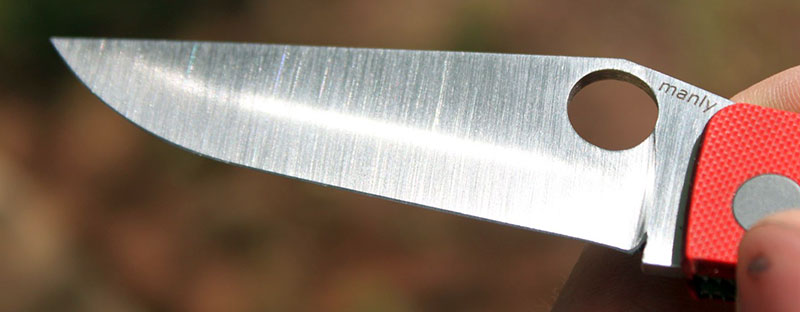
It feels like more than that when you’re using it, but we’ll get to that in the field test section. Since the flats on the Peak 2 extend most of the way out to the tip, the Peak has a much more acute angle to the tip so it’s going to be better at piercing things but also more prone to the tip breaking off.
Although the prices are similar, the steels are quite different. The Peak came in Sandvik 12C27 versus the Peak 2’s German 1.2379 (aka D2.) 12c27 is a very fine-grained stainless steel with high corrosion resistance from its 13.5% chromium content. D2 is technically stainless with a 12% chromium content, but in my experience with other knives is prone to staining and patina when used to cut anything acidic. Carbon content on the D2 is much higher at 1.5% versus the 12C27’s 0.6%, so you can expect it to hold an edge appreciably longer than the Sandvik steel will.
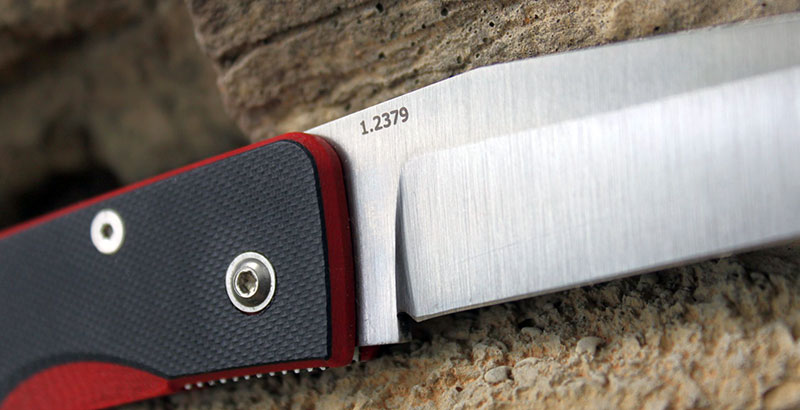
With the prices being similar, you just need to pick based on your intended usage: are you cutting up food? Do you live near the ocean? Then avoid the D2. Neither are hard to sharpen, and the heat treat results (done in-house at Manly’s plant in Bulgaria) are similar, with the 12C27 being rated at 58-60 and the D2 rated at 59-61.
Both knives have a vertical satin finish, and feature the same unique sharpening choil found on the Wasp – a small, acute notch cut into the blade right before the plunge grind. The edge bevel is ground all the way up the leading edge of the sharpening choil and terminates at the plunge grind. The Peak has a bit of a “beard” where the trailing end of the sharpened edge transitions into the choil, but the Peak 2’s edge is cleanly terminated at the choil. Also of note is that the Peak has the same rounded plunge line as the Wasp, while the Peak 2 has a straight plunge line coming off the flats.
Deployment and Lockup
Discussing the deployment of the Peak 2 is a fairly short topic – it’s a two handed opening knife, requiring one hand to hold the handle and the other hand to pinch the spine and pull. The flats on the blade aid in giving you a solid place to grab the blade and open it from, and it’s reasonably smooth when opening because it uses phosphor-bronze washers. Lockup has an authoritative “snap” when the back lock drops into the notch in the blade. It should go without saying, but if you’re looking for a trick to open this with one hand I haven’t found it yet.
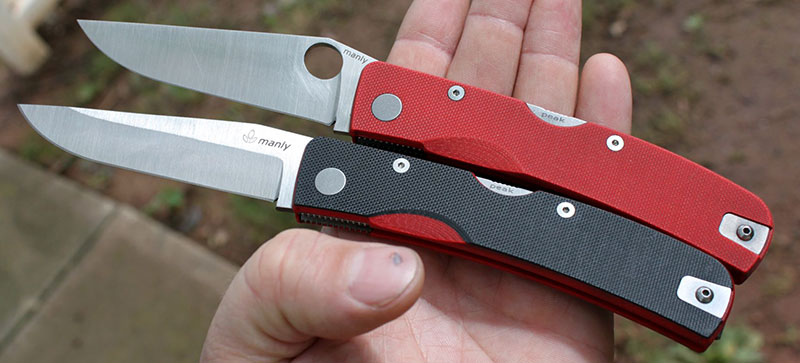
The Peak is designed for one-handed use, and uses an oblong thumb hole (even if it looks like a regular thumb hole in pictures, it’s slightly wider than it is tall) for deployment. Like the Peak 2, it rides on phosphor bronze washers which should break in and become smoother with use. My Peak sample requires disassembly and modification to get a passable one-handed action, because out of the box it was difficult to even open with just your thumb – the pivot was overly tight. Once the pivot was adjusted there was still a lot of extraneous tension to the action even with it loosened to the point of introducing horizontal blade play.
Disassembling the knife, polishing the washers on a ceramic stone, and cleaning everything with solvent and applying a layer of oil solved this problem, with the knife able to be opened easily with the thumb if not “flicked” open – backspring pressure is far too high to allow this knife to fulfill the role of “fidget toy” for compulsive knife flickers, if not Cold Steel levels of tension. With the washers polished and the tension set correctly, you can one-hand close the Peak by releasing the lock with your thumb and giving the blade a downward flick with the wrist, so the tang of the blade contacts the side of your index finger. Then you reposition your hand and use the index finger to fully close the blade. This is a technique that requires a good bit of familiarity with lockbacks and is sure to make any bystanders visibly uncomfortable, to be sure.
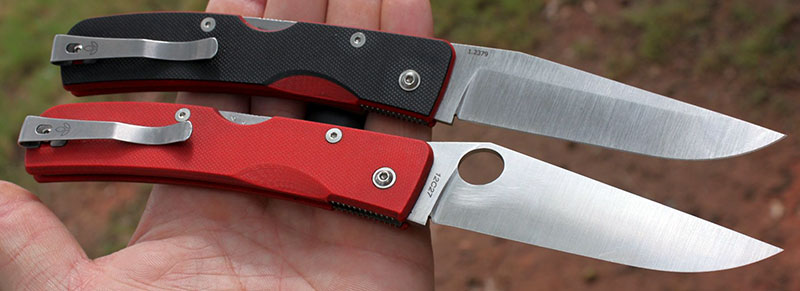
The lock on both the Peak and Peak 2 is a normal lockback devoid of any gimmicks. It utilizes a pretty standard lockbar that’s accessed midway down the spine of the handle. Some lock stick was initially noted when I first started using the Peak but it went away as the knife wore in. The lock is particularly loud when it engages as a result of that strong backspring, dropping into place with a metallic click even when you roll the blade open slowly. Lockup on the Peak is worrisome – with pivot tension dialed in for smooth opening there’s no side to side blade play, but a few degrees of vertical lock rock can be observed – the lock bar itself moving up and down with the blade. The Peak 2 doesn’t suffer from this even though the lock is ostensibly the same between the two knives.
Features, Fit & Finish
As far as features go, the Peak and Peak 2 both use a deep carry bent steel pocket clip that’s configured for ambidextrous tip up carry, and is secured into a recessed pocket by a single screw that it slides around. It comes configured for right hand tip up carry and uses a small “blanking plate” to block off the opposite side not in use, which can be switched around if you’re left-handed. Jimping can be found in only two spots – a very short run of it on the lockbar where your thumb presses down to release it, and on the forward-most portion of the underside of the handle to prevent your fingers from sliding forward onto the blade.

Frankly it’s nice to see jimping applied to places where it’s useful and not slathered all over like a tactical decorative applique. Construction is textured G10 on top of stainless steel nested liners, held together with four body screws and two clip screws, and a Chicago-style pivot screw and barrel. Unusually, the Peak knives use allen screws rather than torx screws – but the knives come with an allen key to adjust or disassemble the knives, which is a nice touch.
The Peak 2 that Manly sent us features a set of unique two-tone scales that are red on the inside and black on the outside, and the top layer is cut away in a scallop shape revealing the red inner layer – presumably for easy access to the thumb hole, which isn’t present on the Peak 2. The Peak has solid red G10 scales which also have the pronounced thumb hole cutout on both sides, and it makes sense that Manly wouldn’t produce a different set of scales for the Peak 2 just to remove the thumb hole access – it’s just odd to see.
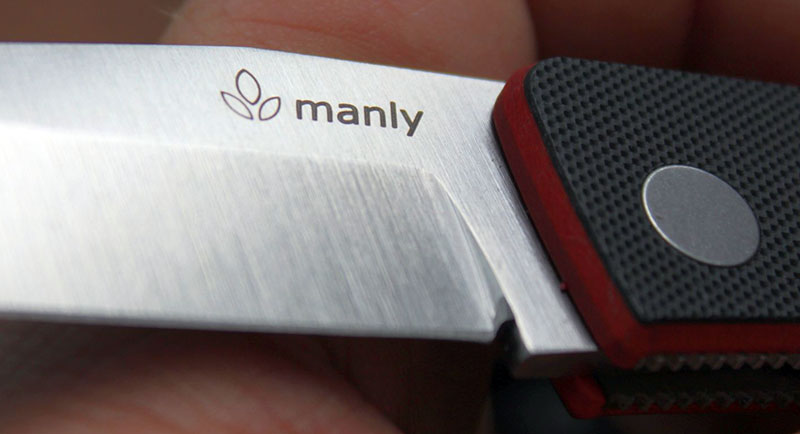
Fit and Finish on both knives is unimpressive. The edge grind on the Peak is nice, but the edges of the thumb hole still had a fairly sharp burr on both sides that had to be knocked down with an emery cloth. The body screws are uneven, the forward pair sitting above the scale and the rearward below. The backspacer that anchors the lock spring is totally uneven with the spine of the scales, at points going below and above the scales.
The blanking plate for the clip sits below the surface but the screw that holds it sits above, and it’s too short on the butt end. The jimping on the lockbar release is crooked, and when the blade is open the spine of the blade doesn’t line up with the lock bar by a fairly wide margin. The edge of the spine on both knives is somewhat messy, and having the edge grind continue up onto the sharpening choil and into the ricasso seems more by accident than by design. They’re tough and functional knives but these quality faux pas will drive fit and finish fanatics nuts, and they seem out of place on knives with $60-$90 MSRP’s.
Field Test
I ended up using the Peak a lot more than the Peak 2 – while I didn’t find the lack of one-handed opening to be such a liability with the Wasp, the lack of an opening option on this big lockback seems more designed to conform to local legislation than it does a deliberate design feature. Most situations one would use a knife like this – camping comes to mind, certainly – would just be better if you could open the knife with one hand.

The oblong hole of the Peak works fairly well as far as “variations on the theme” of the Spyderco round hole go. The angled scallop in the scale lines up well with the wide point in the thumb hole allowing you to open the knife easily. Ergonomics are neutral on both Peak models, without any finger choils or grooves to force a certain grip position. There’s a pronounced thumb ramp on the Peak owing to the thumb whole that’s missing on the Peak 2, which gives you a more solid forward grip when you’re choking up for detail cutting.
The full flat grind of the Peak versus the chunky saber grind of the Peak 2 also results in better slicing performance, giving the nod to the one-handed knife in terms of cutting performance and ergonomics. The Peak 2’s lock is more solid, exhibiting none of the vertical lock rock that plagues the one handed knife, but considering the handle shapes and internal hardware are identical between the two that’s likely down to a production error rather than a design flaw.
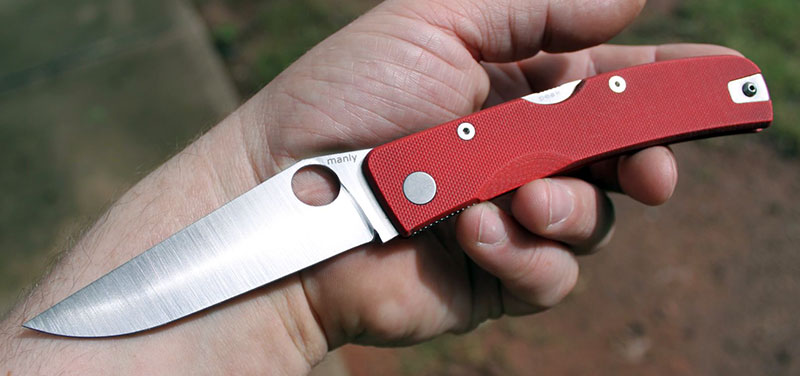
Both knives carry well, the spring style deep carry clip burying the knife fully in the pocket with none of the handle visible. The clips are prone to catching on car doors and the like due to the wide opening angle at the end, though- it could benefit from being turned down a few degrees. The knives are long and narrow so they don’t take up a ton of pocket space, and they’re not too heavy at 4 ounces (according to Manly’s site.) The Peak 2 is marginally better in pocket than the Peak due to the narrower profile of the blade, but it’s more of an academic difference. The exposed tang in the closed position is more pronounced on the Peak than the Peak 2, but both suffer from it.
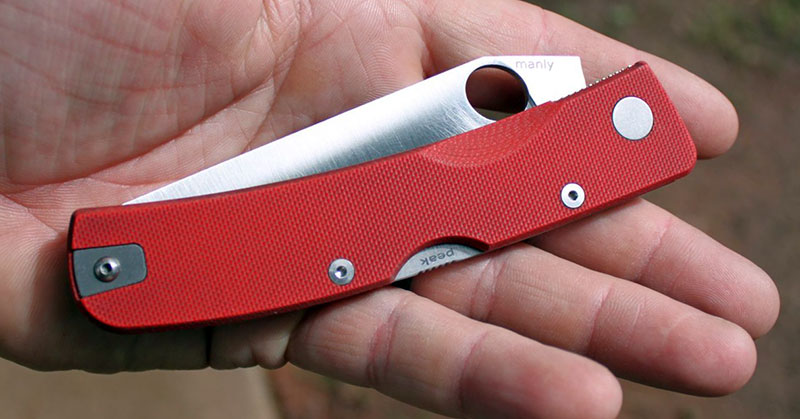
Differences in blade steel aren’t as pronounced as you might think. D2 (or 1.2379 here) holds an edge a little better than Sandvik 12C27, but the stainless steel is easier to sharpen with basic equipment (like a Sharpmaker) and isn’t prone to patina and discoloration if you use the knife to cut food. The biggest difference between the two performance wise is that the Peak cuts better than the Peak 2 due to the more acute primary grind angle due to the full flat grind – the Peak 2 is thicker behind the edge and doesn’t slice through material as effortlessly as the Peak does. The stronger spine of the Peak 2 might be useful for camping activities, but if you’re going to split wood you should really be using an axe, shouldn’t you?
Alternatives
All these knives available at BladeHQ.
The first alternative that comes to mind for the Peak is the Spyderco Endura – it’s a big “no frills” kind of lockback knife with a 3.7” blade just like the Peak. It’s more expensive – a basic full flat ground Endura in VG-10 steel is ~$80 now, while the 12C27 peak is around $60 and the D2 Peak is around $65. VG-10 isn’t the most up to date high performance stainless steel – a bit better than 12C27, a bit worse than D2 in my experience, but you can also buy a Peak/Peak2 in CPM S90V – which is more analogous to the ZDP189 model in terms of performance, and that’s $99 compared to the $120 for the ZDP Endura – so generally around $20 cheaper than a similar Endura model.
The Endura is about a half-ounce lighter – it uses FRN with skeletonized liners – but it feels like a bigger difference. It has a four-way clip and better ergonomics, and is generally better built in terms of quality and fit and finish – but it’s more expensive.
The new “slim” version of the evergreen Buck 110 is also similar. Especially in Pro form with G10 or canvas micarta scales, it distills the no-nonsense idea of the 110 into a thinner, lighter (only 2.8 ounces!) package that now includes modern niceties like a pocket clip. It still has the lockback release at the very back of the handle making it unreasonably annoying to close, and the pocket clip itself is atrocious, and it still uses pinned construction for some reason. But the 3.75” clip point blade made from CPM S30V with Buck’s excellent Paul Bos heat treatment might help you overlook its other downsides.

Cold Steel is one of the few brands that still makes a wide variety of lockbacks these days. The Cold Steel Code 4 is another good alternative. The big difference is it uses aluminum handle scales rather than G10, but it’s remarkably thin at 0.35” across. It uses Andrew Demko’s Tri-Ad lock, a modified backlock with a stop pin interfacing between the blade and the lock bar. You have your choice of a drop point, clip point, and tanto all in CPM S35VN. They’re a bit heavier than the Peak at 4.15 ounces, but they’re super tough and carry very well in the pocket. Retail is around $80. The Large Voyager is a good alternative as well, offering lightweight FRN construction with the strong Tri-Ad lock, and AUS-10A steel in either a tanto or a clip point blade shape for $60 retail.

Another interesting option is the Italian-made Fox Knives 500 lockback. It has a 3.5” full flat ground drop point blade in 440C, and contoured G10 in various colors over stainless liners with a lockback closer to the rear of the handle a la Buck. It’s been designed for sheath carry (so no pocket clip) and only weighs 2.5 ounces despite a 7.75” overall length – a remarkable ratio for a lockback of this size.

The Boker Plus Patriot is slightly shorter overall – a 3.4” blade and 7.5” long – but offers pretty good ratios – it’s only 2.1 ounces. This is the first knife that Boker has made in the USA, and it’s another no-nonsense EDC option for those that prefer a lockback. The blade is made from satin finished 154CM, and uses a thumb stud to open. GFN handle scales have aggressive texturing for a positive grip, and like the Peak it has a deep carry clip that’s configured for ambidextrous tip up carry. It’s not a bad deal at ~$85, either.

Wrap-up
The Manly Peak and Peak 2 seem like knives that get the basic idea right – they’re a distinctly good value for the money, and they carry and cut well – but get a lot of the details wrong, especially as relates to build quality. The number of visibly apparent flaws – as well as the vertical lock rock on the Peak – aren’t acceptable at the prices Manly is asking for these knives. Neither is the particularly bad action on the one-handed Peak model, requiring disassembly and modification to be able to easily use the knife as intended. The uneven surfaces and sharp edges give the impression of a half-finished product, or a pre-production prototype. The bones are good – it’s long and thin and is light for its stout build (and it’s good looking in a rugged, no bullshit kind of way), but the details need work.
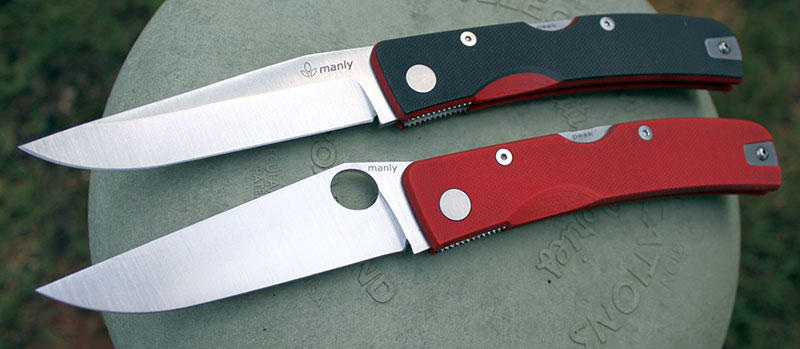
As regards the Peak versus the Peak 2, as someone that lives in a place with no legal regulation of one-handed opening, the Peak 2 seems pointless. The more obtuse angle of the primary bevel on the Peak 2 means it’s not as good of a cutter, and the Peak was clearly a knife designed to be used one-handed. If you’re fond of two handed knives there’s nothing wrong it, but it presents no advantage over the thumb hole equipped Peak.
UPDATE – Manly has been acquired by none other than Boker knives!
- Good value for money, choice of blade steels and colors, Peak has good blade geometry for cutting performance, comes very sharp from the factory, great clip
- Poor build quality, vertical lock rock on Peak, Peak 2-handed model seems pointless if one handed knives aren’t illegal where you live
Manly Peak
Quality/Performance - 68%
Value for Money - 77%
73%
The Bulgarian competitor to the Endura isn’t quite ready for its close-up.





